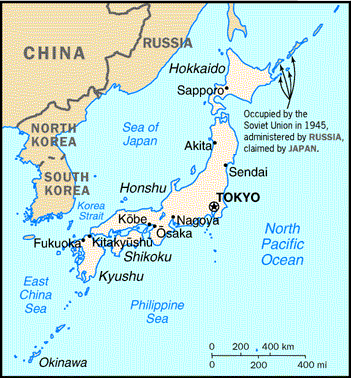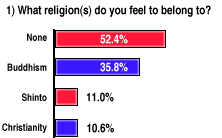Introduction
Japan’s creation as a society is always associated to the sun goddess whom it is believed was the mother to the emperors (Family Education Network, N.d), but the first emperor believed to have ruled the society in 660 B.C is Jimmu.
Basically, the written documents show that the society is believed to have emerged during A.D. 400, when the Yamato clan, originally found in Kyoto succeeded in executing control over other family groups in regions of central and western Japan. During this period, Japan was influenced by Korea who introduced Buddhism to the society, but later in the 700s, Japan was greatly influenced by China’s socio-economic and political elements.
By 2007, Japan had a population of 12,790,000 people (Szczepanski, N.d), and is characterized as one of the countries of the Asian region that experience low birth rate with the majority of the population being old people. The major cites of the country include: Yokohama, Nagoya, Sapporo, Kobe, Kyoto, and Fukuoka (Szczepanski, N.d).
Geographical location of Japan
Japan is composed of numerous islands but the four greatest ones are; Honshu, Hokkaido, Kyushu and Shikoku (Japan-guide.com, N.d). Basically, the country is bordered by Korea, Russia and China; however, over fifty per cent of the country is mountainous and covered by forests. Politically, the country has been divided into eight regions and forty-seven prefectures (Japan-guide.com, N.d).

Political organization
Japan operates on principles and rules that are constructed and based on Constitutional monarchy while at the same time adhering to the Parliamentary government (Maps of World, N.d).
Unlike earlier, the Japan’s emperor has fewer powers in the government functioning but largely participates in major issues related to the government. On overall, the emperor has been made ceremonial and is largely viewed as representative of the state and a symbol of unity among the Japan’s people (Maps of World, N.d).
Japan’s cultural dimensions
Religion
Japan has had two main traditional religions that complement each other although statistics have shown that majority of the population are not religious (Japan-guide.com, N.d).
Shinto is the oldest indigenous religion of Japanese people that majority are affiliated to. Further, a number of other people have embraced Buddhism which is a religion that was imported from Korea during the sixth century. During the early days, especially the Edo era, foreign religions were barred from Japan’s society and this made people to have slow acceptance of the foreign religions.

Hofestede’s, Tromrenaar’s Hall’s Dimensions
Normally, foreigners visiting Japan tend to experience a very distinct culture from their own. The overriding but often wrong impression has been that all people are viewed to be the same, a fact that turns out to implicate some people negatively. Basically, Kalman (2009, p.3) sees culture as the way different people live and is manifested in clothes people wear, food they eat, language they talk, stories they tell and generally the way they conduct themselves.
Hofstede on his part views culture as the ‘software of the mind’ that makes categories of various groups in society basing on their striking differences (Steers, Sanchez-Runde and Nardon, 2010, p.48); and although all people have the same hardware, their brains and patterns of thinking and behaving cannot be the same.
Culture in most cases controls behavior by putting pressure on individuals and social groups into accepting and following normative behavior. Japanese culture has largely been influenced by China, which has been seen as a source of leadership and inspiration, a cultural stimulus and also as a cultural storehouse. One captivating features that Japanese people demonstrate is the ability to borrow and adapt from other cultures and still retain their own individuality and their own unique style (Morton, Morton and Olenik, 2005, p.3).
Hofstede offers five characteristics of cultural dimensions and how they apply to each specific country:
- Power Distance Index (PDI) – this is the extent to which those in society’s organizations and institutions exhibit little powers in terms of accepting or expecting that power to be distributed unequally;
- Individualism (IDV) – some societies have a higher manifestation of individualism whereby ties that bind individuals are loose and hence different individuals are required to look after themselves and only his immediate family;
- Masculinity (MAS) – when it is weighed by femininity, it generally refers to the ways different roles are distributed between the genders;
- Uncertainty Avoidance Index (UAI) – this aspect shows how a society is able to tolerate uncertainty and the ambiguity and in most cases, it refer to people’s search for the truth;
- Long-Term Orientation (LTO) – this aspect deals with virtue with less regards to truth whereby in most cases, values that are linked to Long Term Orientation are frugality and perseverance while values associated with Short Term Orientation are respect for tradition, accomplishing social goals and doing everything to protect acts that might drive individual into shame (Hofstede, N.d).

Management Across cultures (Case studies)
Most studies have shown the characteristics of Japan culture whereby they view themselves in collectivistic rather than in individualistic terms and at the same time they have a high need to refrain themselves from uncertainty (Monden, 2000, p.463).
Toyota America
Toyota Company prides itself in being one of the global multinational companies which has established strong presence in USA. With its geographically managed structure, the company largely has flat hierarchy, decentralized management and bottom-up approach where employees are allowed to take part in new product development, product modification and share decision making (Bell, Prest and Chong, N.d, p.9).
Both junior staff and management in the company have the same uniform, car-park and cafeteria and they together engage in company songs, ceremonies and social gatherings as one. This aspect has helped the company to build and maintain a strong culture which in turn has given rise to employee empowerment, job enrichment and employee commitment to the company (Bell, Prest and Chong, N.d, p.9).
The company has totally viewed its employees as an important resources by maintaining a good relation with them through great concern for their welfare, skill improvement workshops, giving loans at low rate, providing housing subsidies access to recreational facilities and retirement allowance (Fang & Kleiner, 2003 cited in Bell, Prest and Chong, N.d, p.9 ). One major aspect that Toyota has had to change in terms of culture is the element of individualism in American society.
Honda Motors
Honda Motors is a Japanese company which started off as a maker of motorcycles in mid 1960s before venturing into automobile manufacturing. Honda Motors has largely promoted a ‘human-centered approach to work and its standards are less rigid. Employees normally interchange and rotate tasks assigned to them hence reinforcing the aspect of flexibility.
But since establishing its presence in Northern America, Honda has promoted individualism, youth promotion in the company and remarkable level of equality whereby the Japanese culture emphasize the opposite and favors, groupism, seniority and status. Therefore the company has been determined in addressing the organizational rigidity which Japanese culture promotes.
Conclusion
Multinational corporations in the globalizing world are faced with numerous challenges which continue to position the corporations in a state of flux, thus it has become prerequisite for the concerned corporations to be dynamic. Different countries have unique cultures which in turn affect their daily activities.
The culture also becomes part of the people of the specific country and aspects of such culture dictate the behavior of the individual even in different environments. Therefore, it has become paramount to multinational corporations to learn cultures of different societies they operate in or intend to establish their presence, thus helping them to overcome obstacles that arise as a result of cultural shocks.
Reference List
Bell, B., Prest, S. and Chong, B., Toyota: Multinational Corporation Analysis in United States of America and Japan. Web.
Family Education Network. Japan. Web.
Hofstede, G. Cultural Dimensions. Web.
Japan-guide. Geography. Web.
Kalman, B., 2009. What Is Culture? NY, Crabtree Publishing Company. Web.
Maps of World. Government Japan. Web.
Monden, Y., 2000. Japanese cost management. N. J., World Scientific. Web.
Morton, W. S., Morton, W. S. and Olenik, J. K., 2005. Japan: its history and culture. NY, McGraw-Hill Professional. Web.
Steers, R. M, Sanchez-Runde, C. J and, Nardon, L., 2010. Management across Cultures: Challenges and Strategies. NY, Cambridge University Press. Web.
Szczepanski, K. Profile of Japan. Web.